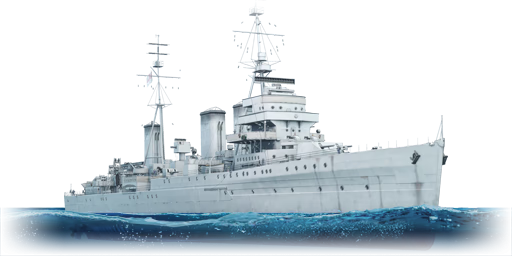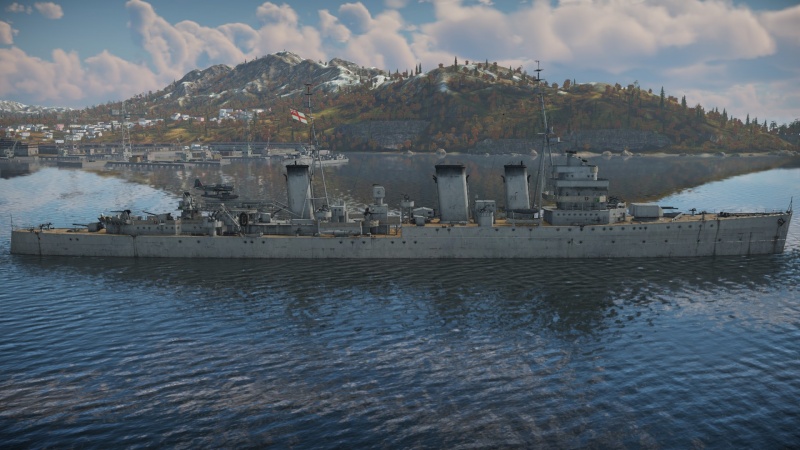HMS Enterprise
Contents
Description
The Emerald-class, HMS Enterprise (D52), 1944 is a rank III British light cruiser with a battle rating of 4.7 (AB/RB/SB). It was introduced in Update 1.83 "Masters of the Sea" as part of the British fleet closed beta test.
General info
Survivability and armour
Talk about the vehicle's armour. Note the most well-defended and most vulnerable zones, e.g. the ammo magazine. Evaluate the composition of components and assemblies responsible for movement and manoeuvrability. Evaluate the survivability of the primary and secondary armaments separately. Don't forget to mention the size of the crew, which plays an important role in fleet mechanics. Save tips on preserving survivability for the "Usage in battles" section. If necessary, use a graphical template to show the most well-protected or most vulnerable points in the armour.
Mobility
Write about the ship's mobility. Evaluate its power and manoeuvrability, rudder rerouting speed, stopping speed at full tilt, with its maximum forward and reverse speed.
| Mobility Characteristics | |||
|---|---|---|---|
| Game Mode | Upgrade Status | Maximum Speed (km/h) | |
| Forward | Reverse | ||
| AB | |||
| Upgraded | 71 | 30 | |
| RB/SB | |||
| Upgraded | 61 | 26 | |
Modifications and economy
Armament
Primary armament
Provide information about the characteristics of the primary armament. Evaluate their efficacy in battle based on their reload speed, ballistics and the capacity of their shells. Add a link to the main article about the weapon: {{main|Weapon name (calibre)}}. Broadly describe the ammunition available for the primary armament, and provide recommendations on how to use it and which ammunition to choose.
Secondary armament
Some ships are fitted with weapons of various calibres. Secondary armaments are defined as weapons chosen with the control Select secondary weapon. Evaluate the secondary armaments and give advice on how to use them. Describe the ammunition available for the secondary armament. Provide recommendations on how to use them and which ammunition to choose. Remember that any anti-air armament, even heavy calibre weapons, belong in the next section. If there is no secondary armament, remove this section.
Anti-aircraft armament
An important part of the ship's armament responsible for air defence. Anti-aircraft armament is defined by the weapon chosen with the control Select anti-aircraft weapons. Talk about the ship's anti-air cannons and machine guns, the number of guns and their positions, their effective range, and about their overall effectiveness – including against surface targets. If there are no anti-aircraft armaments, remove this section.
Additional armament
Describe the available additional armaments of the ship: depth charges, mines, torpedoes. Talk about their positions, available ammunition and launch features such as dead zones of torpedoes. If there is no additional armament, remove this section.
Usage in battles
Describe the technique of using this ship, the characteristics of her use in a team and tips on strategy. Abstain from writing an entire guide – don't try to provide a single point of view, but give the reader food for thought. Talk about the most dangerous opponents for this vehicle and provide recommendations on fighting them. If necessary, note the specifics of playing with this vehicle in various modes (AB, RB, SB).
Pros and cons
Summarise and briefly evaluate the vehicle in terms of its characteristics and combat effectiveness. Mark its pros and cons in the bulleted list. Try not to use more than 6 points for each of the characteristics. Avoid using categorical definitions such as "bad", "good" and the like - use substitutions with softer forms such as "inadequate" and "effective".
Pros:
Cons:
History
HMS Enterprise (D52) was one of two Emerald-class cruisers built for the Royal Navy at the end of the First World War. Designed as an incremental improvement over the previous ‘D’ Class, the ship carried an improved armament scheme and was capable of higher speeds. Enterprise was completed too late to see service during the First World War, but served extensively in the East Indies during the interwar period. She later received an experimental dual turret at the front, which would be built into the designs of the later Arethusa and Leander class cruisers. Enterprise served extensively during the Second World War in the Atlantic and within home waters; she was eventually scrapped in 1946.
Design and development
The ‘E’ Class, or Emerald class, was designed as a follow-up to the previous D-class cruisers. The ships were designed with a much higher emphasis on speed rather than armour - as a result, they were capable of reaching 33 knots (61 km/h) compared to 29 knots (54 km/h) for the previous class. To achieve this higher speed, the engine block was much larger, delivering almost twice as much horsepower compared to the previous D class. Enterprise herself was fitted with an experimental twin turret in 1930, which proved to be highly successful. As a result, it was retained, and a new superstructure was fitted further forward. This turret would also be inherited by subsequent British light cruiser designs.
Enterprise displaced 7580 tons standard and had a crew complement of 572 officers and crew. Her main armament consisted of seven BL 6-inch (152 mm) Mk 12 mounts in five single and one dual turret. Secondary armament consisted of several 4-inch (102 mm) guns, as well as numerous lower-calibre anti-aircraft guns. Throughout the course of her service, Enterprise’s anti-aircraft armament was improved several times. Powered by steam turbines, Enterprise was capable of making 33 knots (61 km/h).
Operational history
After her commissioning, HMS Enterprise was assigned to the Indies squadron, remaining there until 1928. Her service was relatively quite remarkable in that it resulted in the creation of the Enterprise Cup (from a trophy donated by the sailors of the Enterprise), which remains a hotly-contested rugby competition in Kenya, Uganda and Tanzania. After returning to the UK to receive her new experimental turret, Enterprise returned to the East Indies, remaining there until 1937.
At the start of the Second World War, Enterprise was sent back to the Atlantic where she spent the first several months of war as a convoy escort. She later evacuated 10 million dollar’s worth of British gold (625 million today adjusting for inflation) to Canada as part of Operation Fish, and repeated the same actions transporting a third of the Norwegian gold reserve to the British isles as part of the Norwegian evacuation. She later participated in the negotiations with the Vichy French fleet, and subsequently, the destruction of the French Fleet at the Mediterranean port of Mers-El-Kebir.
In early 1941, Enterprise was reassigned to the East Indies squadron to hunt for the German raider Admiral Scheer; after the start of the war in the Pacific, she rescued sailors from the heavy cruisers Cornwall and Dorsetshire which had been sunk by Japanese forces. In early 1942, Enterprise was redeployed to the home fleet, and later participated in the Battle of the Bay of Biscay, where she sank a German torpedo boat using torpedoes. She served as part of the bombardment force during the D-Day landings, and in October of 1944, was reduced to reserve. After repatriating British troops in 1946, HMS Enterprise was sold for scrap.
Devblog
HMS Enterprise served in the Royal Navy until the end of WWII. This light cruiser has a rich history of exploits and adventures – she served in Shanghai during the disturbances in 1927, participated in the emergency evacuation of Prince Edward from Africa, and transported troops to Hong Kong and the Malay Peninsula. With the outbreak of the Second World War, HMS Enterprise was assigned to the Northern Patrol, where besides protecting British ships, she also transported incredible numbers of gold bars. She later participated in the Norwegian Operation, just barely escaping German torpedoes, and escorted a shipment of British fighters to Malta. She attacked French ships in Mers El Kébir, hunted German raiders in the South Atlantic and Indian oceans, was active in the Persian Gulf, and rescued seamen from the Cornwall and Dorsetshire cruisers sunk by Japanese aircraft. The light cruiser survived fierce battles with the squadrons of the Kriegsmarine along the French coast, she attacked German coastal defenses during the Allied Normandy landings, and provided artillery support for forces advancing across France. Throughout her lifetime, HMS Enterprise travelled the globe, fighting the French, the Italians, the Germans, and the Japanese.
Media
Excellent additions to the article would be video guides, screenshots from the game, and photos.
See also
Links to articles on the War Thunder Wiki that you think will be useful for the reader, for example:
- reference to the series of the ship;
- links to approximate analogues of other nations and research trees.
External links
References
- Helgason, G. (1995). HMS Enterprise. Retrieved January 26, 2021, from https://uboat.net/allies/warships/ship/1215.html
- Mason, G. B. (1999). HMS Enterprise. Retrieved January 26, 2021, from https://www.naval-history.net/xGM-Chrono-06CL-Enterprise.htm
| Britain light cruisers | |
|---|---|
| Emerald-class | HMS Enterprise |
| Dido-class | HMS Dido |
| Leander-class | HMNZS Leander |
| Arethusa-class | HMS Arethusa |
| Town-class | HMS Belfast · HMS Liverpool · HMS Southampton |
| Tiger-class | HMS Tiger |
| Abdiel-class* | HMS Abdiel |





